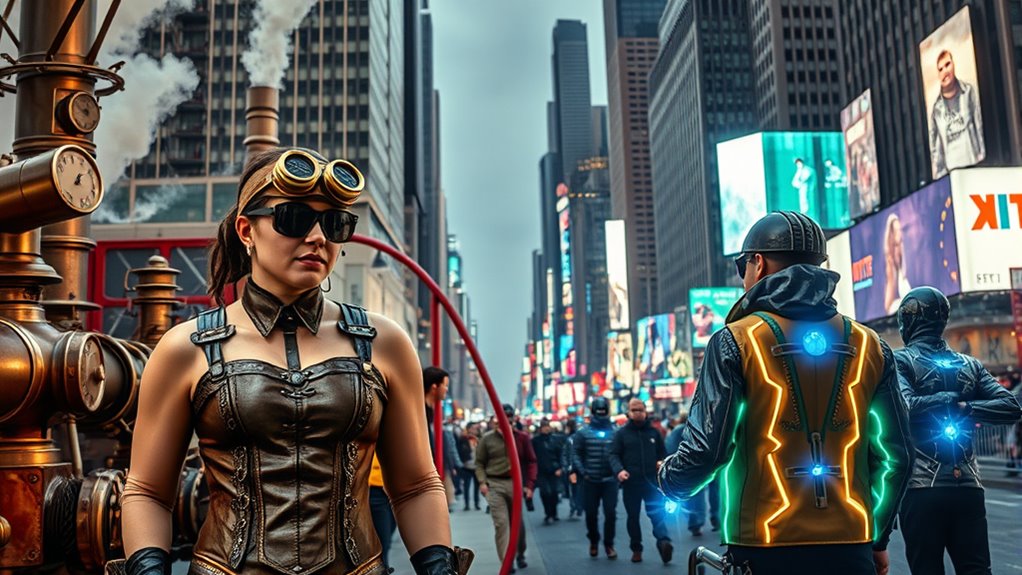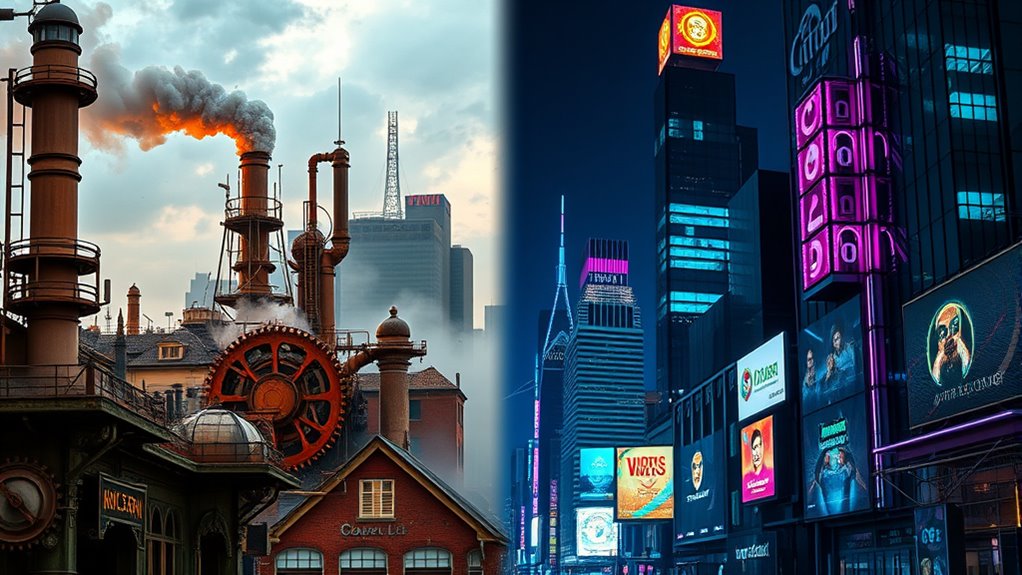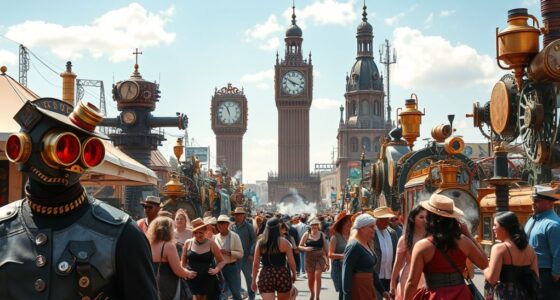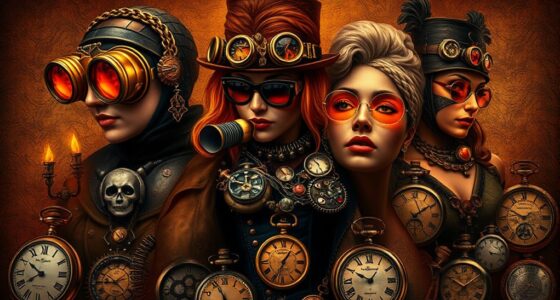If you explore the worlds of steampunk and cyberpunk, you’ll notice their striking visual and cultural differences. Steampunk combines Victorian elegance, intricate craftsmanship, and a nostalgic vibe, focusing on steam-powered technology and adventure. Cyberpunk, however, presents a sleek, neon-lit future filled with digital networks, cybernetics, and dystopian themes. Both challenge your imagination in unique ways, revealing contrasting visions of innovation—history versus the future. Keep going, and you’ll uncover even more about how these genres shape our cultural perspectives.
Key Takeaways
- Steampunk embraces Victorian-era aesthetics with ornate, warm visuals, while Cyberpunk features sleek, neon-lit, futuristic cityscapes.
- The cultural tone of Steampunk is nostalgic and optimistic, contrasting with Cyberpunk’s dystopian and gritty societal critique.
- Visual elements in Steampunk include gears, brass fittings, and leather, whereas Cyberpunk emphasizes digital interfaces, neon lights, and cybernetic enhancements.
- Technologically, Steampunk reimagines steam-powered Victorian innovations; Cyberpunk focuses on AI, cybernetics, and digital networks.
- The genres reflect contrasting themes: Steampunk celebrates craftsmanship and adventure, while Cyberpunk explores societal collapse and technological dystopia.

Have you ever wondered how two popular genres like steampunk and cyberpunk distinguish themselves from each other? Both worlds are vivid, compelling, and immersive, but they tell very different stories through their aesthetics and cultural themes. In steampunk, Victorian innovation takes center stage. Imagine a universe where steam-powered machinery, clockwork gadgets, and ornate brass fittings define everyday life. This genre draws heavily from the 19th-century Industrial Revolution, blending the elegance and craftsmanship of the Victorian era with imaginative technological advancements. You see this in intricate gears, leather-bound books, and airships floating through foggy skies. Steampunk’s charm lies in its nostalgic reverence for a bygone era’s style and ingenuity, even as it reimagines it with futuristic twists. It’s a celebration of craftsmanship, adventure, and a sense of wonder rooted in history. The aesthetic often emphasizes ornate detailing, creating a richly textured visual style that sets it apart from other genres.
Cyberpunk, on the other hand, plunges you into futuristic dystopias where technology has evolved rapidly, often at the expense of social stability. Think neon-lit cityscapes, towering skyscrapers, and sprawling digital networks that define everyday life. The focus here isn’t on Victorian elegance but on a gritty, high-tech world where corporations hold immense power and individual freedom is under threat. Cyberpunk explores themes of surveillance, artificial intelligence, and the dehumanizing effects of technological advancement. It’s a genre that presents a bleak outlook—where society is fractured, and the line between human and machine blurs. You’ll encounter cybernetic implants, virtual realities, and hackers fighting against oppressive systems. It’s a stark contrast to steampunk’s romanticized past, emphasizing the dark side of technological progress and the potential dystopia it can create.
While steampunk’s aesthetic is ornate, warm, and historic, cyberpunk feels cold, sleek, and futuristic. Both genres reflect their cultural anxieties—steampunk channels nostalgia and optimism for innovation rooted in Victorian ingenuity, whereas cyberpunk grapples with fears about unchecked technological growth and societal collapse. These differences shape not just their visual styles but also their narratives, themes, and outlooks. If you love the idea of exploring a world where Victorian innovation and mechanical marvels reign supreme, steampunk offers an optimistic, adventure-filled journey. Conversely, if you’re drawn to stories of corporate dominance, digital rebellion, and a cybernetic future, cyberpunk delivers a gritty, provocative experience. Both genres challenge your imagination, but they do so by contrasting nostalgic craftsmanship with futuristic dystopias.
Frequently Asked Questions
How Do Steampunk and Cyberpunk Influence Modern Fashion Trends?
You see how steampunk and cyberpunk influence modern fashion trends through Victorian-inspired accessories and futuristic streetwear. Steampunk brings in vintage gears, leather, and brass details, making everyday outfits more eclectic. Meanwhile, cyberpunk inspires sleek, tech-inspired looks with neon accents and dark aesthetics. Both styles push boundaries, encouraging you to mix historical elements with modern technology, creating bold, innovative fashion statements that stand out.
What Are Common Misconceptions About Steampunk and Cyberpunk Cultures?
You might think steampunk and cyberpunk are just aesthetic styles, but many misconceptions exist. People often see steampunk as only Victorian costumes or cyberpunk as purely dystopian fantasies, ignoring their deeper cultural roots. Both cultures explore technological nostalgia, imagining alternative futures that challenge societal norms. Understanding these cultures requires appreciating their creative visions and the way they reflect our hopes and fears about technology’s role in society.
How Do These Genres Impact Contemporary Video Game Design?
You see, these genres influence modern video game design through aesthetic innovation, blending retro-futuristic visuals with immersive worlds. They also promote narrative integration, allowing developers to craft compelling stories rooted in unique cultural themes. By drawing on steampunk’s industrial charm or cyberpunk’s high-tech dystopia, you get richer, more distinctive experiences that push creative boundaries and engage players on a deeper level.
Are There Significant Geographic Differences in Steampunk and Cyberpunk Popularity?
Ever wonder if your favorite genre’s popularity varies by region? You might find that geographic popularity of steampunk and cyberpunk shifts based on regional cultural influences. In some areas, steampunk thrives amidst a fascination with Victorian aesthetics and industrial history, while cyberpunk’s edgy, tech-driven themes resonate more in regions embracing digital innovation. These regional differences reveal how local culture shapes genre preferences, making the global landscape of steampunk and cyberpunk fascinatingly diverse.
How Do These Genres Address Social and Political Themes?
You see that both genres serve as platforms for social critique and political activism. Steampunk often highlights class struggles and the impact of industrialization, questioning societal progress. Cyberpunk, on the other hand, explores themes like corporate control and technological dystopias, urging awareness of digital ethics. By engaging with these themes, you’re encouraged to reflect on real-world issues, making the genres powerful tools for social and political commentary.
Conclusion
So, whether you’re drawn to the brass gears and Victorian elegance of steampunk or the neon-lit, high-tech chaos of cyberpunk, both worlds ignite your imagination. You might think one is more realistic than the other, but picture yourself walking through a foggy, steam-powered city or exploring a glowing cityscape buzzing with holograms. Both styles invite you to dream beyond the present—so why choose? Embrace the adventure, and let your imagination run wild.









